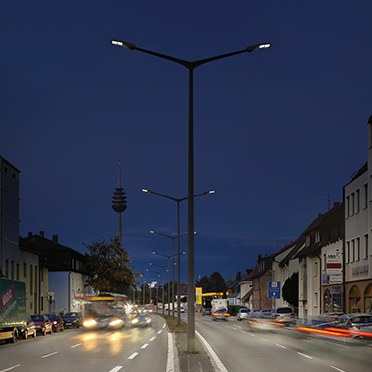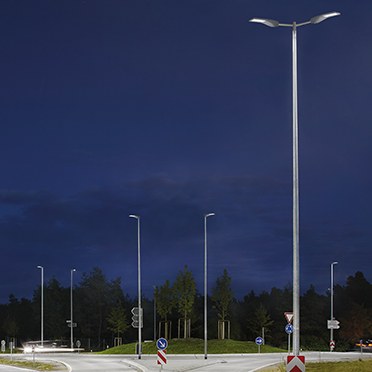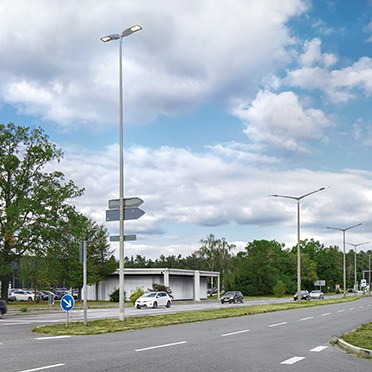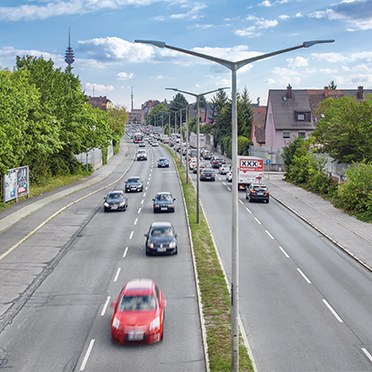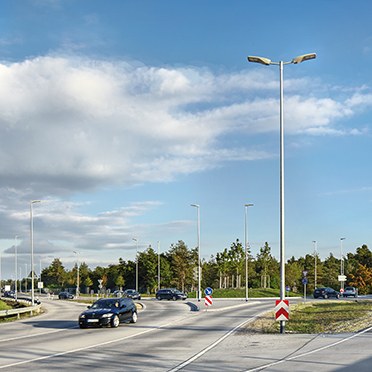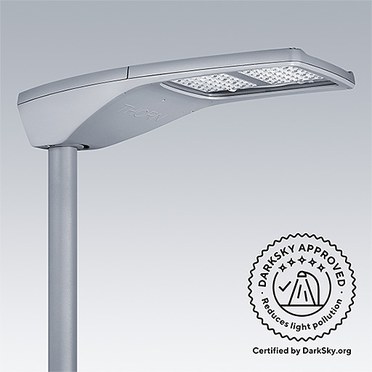City of Nuremberg, Germany
Products
- Lamp efficacy
Lamp efficacy
Ensuring the lamp efficiently converts electricity into light (lm/W).
- Ballast classification
Ballast classification
Controlling the electricity supply to the lamp (Energy Efficiency Index).
- Luminaire distribution
Luminaire distribution
Controlling light emission using optics which bend and shape the light to the correct location.
- System efficacy
System efficacy
Combining optical and thermal control within the luminaire (luminaire lm/W).
- Presence/absence detection
Presence/absence detection
Presence: Lights automatically turn on/off with movement. Absence: Lights automatically turn off and must be manually switched on.
- Daylight detection
Daylight detection
Artificial lighting which responds to the natural light conditions.
- Constant illuminance
Constant illuminance
A function designed to produce correct light levels for the duration of the maintenance period.
- Task-scene setting
Task-scene setting
Allowing the user to set scenes and adapt the lighting to different tasks.
- Timed off
Timed off
Automatic cut-off can be installed to turn all lights off during unoccupied hours.
- Task lighting
Task lighting
Lighting task areas with the correct amount of light.
- Zoning of lighting
Zoning of lighting
Lighting is zoned according to area use.
- Maintenance schedule
Maintenance schedule
Maintenance must be performed in response to product age, performance and environment.
- Waste light
Waste light
Eliminating waste light which does not hit the intended target.
- Reflectance
Reflectance
Taking advantage of light which is reflected from the surface within the space.
- Visible smart metering
Visible smart metering
Results of actions can be quickly seen as increased or decreased energy use to encourage responsible energy consumption.
The best kilowatt hour is the kilowatt hour that is saved.
Nuremberg is a true pioneer when it comes to efficient urban lighting. Innovative R2L2 LED street lights from Thorn play a major role here, fulfilling a range of different lighting tasks with tailored illumination levels and task-specific light distributions.
“Saving energy is the finest form of alternative energy. The best kilowatt hour is the kilowatt hour that is saved.” This is the motto of Nuremberg – and a motto that is impressively confirmed by a new street lighting concept in the German city. Even though the network of illuminated streets and roads has expanded from 1160 kilometres to 1204 kilometres over the last 20 years, energy consumption in 2016 actually declined from 22.8 million kWh (kilowatt hours) to 15.3 million kWh. A further reduction to little more than 15 million kWh is expected in 2017. This impressive change has been in part achieved by successively renewing approximately 1500 luminaires each year, starting with those that have the longest operating periods. These new lighting solutions have improved energy efficiency and replaced out-dated fittings, representing a real technological step forward. This progress is perfectly illustrated by the contemporary R2L2 LED street lanterns from Thorn Lighting, which first started to complement the Nuremberg cityscape in 2014.
14.1% of the 48,000 street lights in Nuremberg are now equipped with LED technology.
Norbert Hirschmann, Head of City Lighting in the SÖR/1-E section of the public spaces service team, explained: “This change was accelerated by the so-called municipal guideline. Since 2008 the Federal Ministry for the Environment, Transport and Nuclear Safety has been supporting local authorities with upgrading public outdoor and street lighting from conventional mercury, high-pressure sodium vapour or fluorescent lamps to LED technology with lighting controls and regulation technology – just as long as the carbon dioxide emissions are reduced by at least 60 percent.”
Despite the fact that the funding rate was reduced to 20 per cent, Norbert Hirschmann was still very much of the opinion that this programme makes sense on various levels. It was therefore no surprise when Nuremberg also applied for inclusion in the subsequent initiative that was launched in spring 2013.
Last year new LED street lighting helped save more than 0.5 million kWh.
These measures are especially important when it comes to reducing the impact of the significant increases in electricity costs caused by recent renewable energy legislation. Even though the introduction of LED has seen the overall connected load for street lighting reduce steadily, saving the Nuremberg local authorities more than 0.5 million kWh every year, energy prices rose markedly between 2011 and 2013. Genuine cost benefits were therefore only achieved when energy prices finally began to stabilise.
A carefully considered approach
The public tender for the LED street lighting included a mixture of technical parameters and design requirements. Every luminaire to be considered for inclusion in the programme was initially subject to a trial installation period, enabling the authorities to fully evaluate the suitability of the various fittings. This appraisal process also covered assembly and maintenance, as the costs associated with these factors make them important selection criteria. A high IP66 protection class means that LED luminaires are less prone to invasive elements like dirt and moisture, while excellent levels of reliability guarantee extra peace of mind. As a result, the four-year maintenance cycle for conventional technology could be extended to five years for LED products in Nuremberg.
A total of 1512 of the preferred luminaires from various manufacturers were installed between August 2013 and September 2014. This number included R2L2 LED street lanterns from Thorn, which fulfilled all the necessary requirements and represented the most cost-effective solution on the list. As Norbert Hirschmann points out, “any difference in price was therefore no major issue.”
Sleek, modern and timeless
A core feature of the R2L2 street lantern is precisely calculated lens technology, which has paved the way for the development of individual lens clusters. These can be combined and integrated into the die-cast aluminium housing to create various luminaire sizes and light outputs of up to 30,000 lumens. In this way, both the luminous flux and the light distribution can be specified to suit the particular lighting task. The twelve different optics provide a carefully defined distribution without any stray light, helping to fulfil the varied lighting requirements of any public space: from wet roads to narrow, wide and extra-wide routes such as motorways; from footpaths and bike lanes to pedestrian crossings.
Yet a series of other features further add to the appeal of this street luminaire, which has been developed around a central concept of durability. The integration of high-performance R-PEC LED optics into the third generation of the R2L2 range has enabled the total number of components to be reduced, simultaneously lowering the likelihood of technical failure and improving serviceability.
Ease of maintenance is further enhanced by the water-resistant and dust-repellent surface of the luminaire head, which performs the additional task of effectively dissipating heat and thereby extending the operating life of the LEDs.
Norbert Hirschmann: “For a technical luminaire, the R2L2 has a very attractive appearance. The pleasant design blends harmoniously into the cityscape.”
Task-specific solutions
At the appropriate mounting height, the blend of slender luminaire and cantilever provides an interesting visual contrast to the more robust concrete pole. Factor in the advanced technology and it is clear to see why the R2L2 lantern represents an impressive all-round solution.
The local authorities in Nuremberg opted for the medium-sized version. With a length of 880 mm, a width of 370 mm and a height 155 mm, this variant can achieve a system efficiency of up to 136 lumens per Watt (lm/W). A total of 1800 R2L2 street lanterns with three different performance levels were installed, featuring combinations of three different power levels and either NR optics for narrow streets or WSC optics for improved comfort on wider roads. This batch of solutions helps meet the specific requirements of the various urban locations.
Around 1400 street lanterns are configured with 72 LEDs and an operating current of 350 mA. Delivering a luminance of 0.75 cd/m2 at a mounting height of approximately 10 metres, these R2L2 fittings are suitable for illuminating two-lane main roads in the lighting category ME 4a (according to DIN 13201). Three-lane and four-lane roads feature versions with taller masts, 84 LEDs and 500 mA. Large R2L2 luminaires with 96 LEDs and an operating current of 500 mA can be found at busy intersections with greater traffic density, in areas with more complex traffic management systems and at locations with a higher accident risk. As a result, Nuremberg has consciously exceeded the requirements of DIN 13201 to ensure optimum safety for road users.
Each individual route has been finely calculated using a special computer programme. The mast specification and mounting heights depend on the particular road geometry and the selection of single or double luminaire heads, which are characterised by a subtle and yet robust design and easy installation - thanks in no small part to the integrated cable pull-in device. The mounting heights of the light points range from 4 metres in residential streets to over 16 metres on main traffic routes. The challenge of lighting especially wide streets is met by a series of luminaire heads installed at 25 metres. This is the only way to truly achieve comprehensive lighting uniformity – a key factor when it comes to supporting the accurate perception of vehicles, people and objects on the road.
Experience in practice
After nearly three years of operation, the overall results have been extremely positive. The product design and high-quality look continue to impress, while the various combinations of LEDs, lens technology and control gear have more than matched initial expectations. The installation has certainly made a good impression on Norbert Hirschmann: “We have only had issues with 15 of the 1800 R2L2 street lanterns. That is a very good ratio.” Equally pleasing is the fact that these Thorn luminaires have delivered annual savings of 800,000 kWh when compared to the original high-pressure sodium vapour lamps.
The project has also delivered a shift from yellow light to significantly whiter LED light with a colour temperature of 4000 K. Certain residents were somewhat sceptical, but initial reluctance soon turned to clear acceptance when the benefits of improved energy efficiency were explained - especially as neutral white LEDs are markedly more efficient than the equivalent warm-white LEDs with 3000 K. Lowering the luminous flux to 50 per cent between 9:00 pm and 6:30 am has also helped deliver further energy savings. Taking all these factors into account, it is not hard to see why Nuremberg is now being hailed as a true pioneer in the world of urban street lighting.
Download City of Nuremberg case study as a PDF here.
Photographer: Andrea Flak

